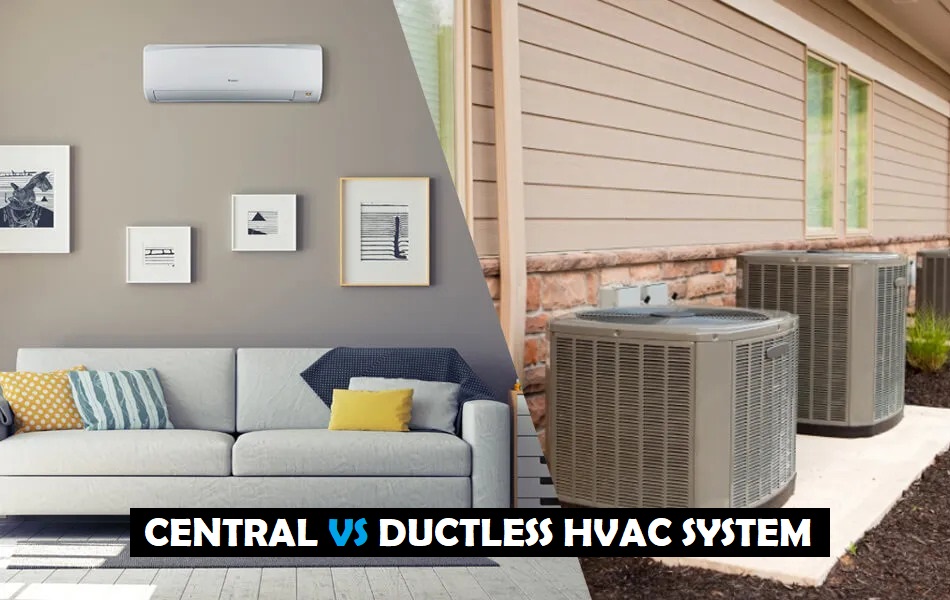When it comes to HVAC systems, homeowners are faced with many options. Among the most common choices are central HVAC systems and ductless HVAC systems. These two alternatives differ significantly in terms of their design, functionality, and advantages. In this detailed exploration, we will delve into the distinctions between central and ductless HVAC systems, helping you decide which one best suits your home’s specific needs.

Understanding Central HVAC Systems
Central HVAC systems, often referred to as traditional HVAC systems, have long been the stalwarts of home climate control. These systems are renowned for their capacity to provide both heating and cooling to an entire household from a central unit. Let’s take a closer look:
1. Ductwork Dependency
A defining characteristic of central HVAC systems is their reliance on a network of ducts. These ducts serve as conduits for transporting conditioned air throughout your home, ensuring that every room receives an even distribution of warm or cool air. This uniformity is often prized in larger residences, where maintaining consistent temperatures is crucial.
2. Comprehensive Climate Control
Central HVAC systems offer comprehensive climate control. They empower homeowners to set and maintain a consistent temperature throughout their entire home. This level of control is particularly advantageous in larger houses with multiple rooms.
3. Installation Complexity
Installing a central HVAC system can be a relatively complex undertaking and often necessitates professional assistance. The process involves the installation of ductwork, which can be both time-consuming and costly. However, the result is a system that can efficiently heat or cool large spaces.
4. Energy Efficiency
Central HVAC systems can be highly efficient, especially when cooling expansive areas. The efficiency, however, can vary depending on factors such as the quality of duct insulation and sealing. Proper maintenance is essential to ensure optimal energy performance.
Exploring Ductless HVAC Systems
In recent years, ductless HVAC systems, also known as mini-split systems, have gained significant popularity. These systems offer a fundamentally different approach to home heating and cooling:
1. Ductless Operation
As the name suggests, ductless HVAC systems do not rely on ductwork. Instead, they consist of an outdoor unit and one or more indoor air handlers, which are connected by refrigerant lines. This design makes them an excellent option for homes without existing ducts or room additions.
2. Zoning Capabilities
One of the standout features of ductless systems is their zoning capabilities. Each indoor unit can be controlled separately, allowing for customized temperature settings in different rooms. This level of individualized control can lead to significant energy savings by avoiding the heating or cooling of unoccupied spaces.
3. Installation Ease
Compared to central systems, ductless HVAC systems are typically easier to install. They require minimal construction work since there’s no need for duct installation. This streamlined installation process often results in lower upfront costs and less disruption to your home.
4. Energy Efficiency
Ductless systems are renowned for their energy efficiency. Because they allow for individualized climate control, you can avoid wasting energy on heating or cooling rooms that are not in use. This targeted approach can lead to substantial long-term savings on energy bills.
Making the Right Choice
When it comes to choosing between central and ductless HVAC systems, there’s no one-size-fits-all answer. The decision should be based on your specific needs and circumstances. Here are some critical factors to consider:
1. Home Size
For larger homes with existing ductwork, central HVAC systems may be a suitable choice, as they can efficiently handle the heating and cooling requirements of a spacious interior. They are particularly effective at maintaining consistent temperatures in extensive living spaces.
2. Energy Efficiency Goals
If energy efficiency and cost savings are top priorities, ductless HVAC systems offer a clear advantage with their zoning capabilities and minimal energy wastage. These systems are designed to adapt to your usage patterns, ensuring that you only heat or cool the areas that need it.
3. Installation Considerations
Consider the ease of installation and associated costs. Ductless systems are often more budget-friendly in this regard, and they can be a viable option for older homes or room additions where adding ductwork would be impractical.
4. Aesthetics
Ductless systems can be less intrusive in terms of aesthetics. The indoor air handlers are compact and can be mounted high on walls or ceilings, providing flexibility in placement and design.
In the central vs. ductless HVAC debate, the best choice ultimately depends on your unique circumstances and preferences. Both systems have their merits and drawbacks. To make an informed decision, assess your home’s specific requirements, budget, and energy efficiency goals. Consulting with an HVAC professional can provide valuable insights tailored to your situation, ensuring that you enjoy optimal comfort and energy savings in your home.




